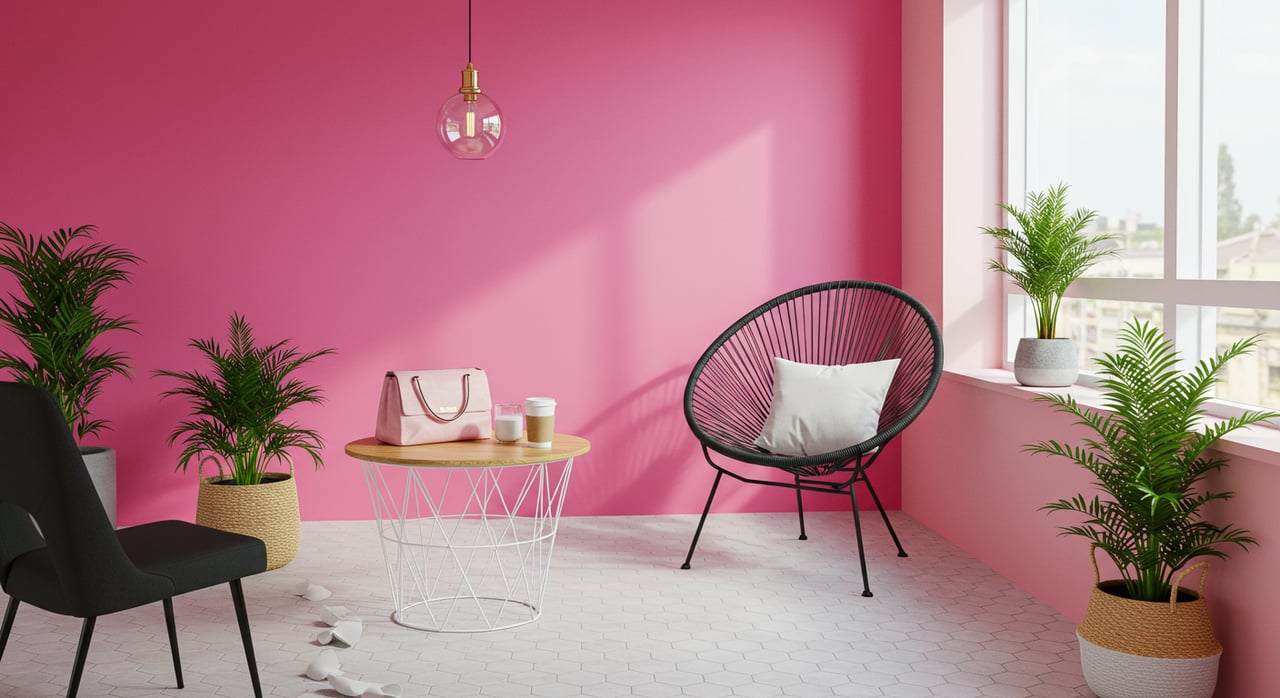Choosing the right paint color for your home can be an exciting yet daunting task. With thousands of shades and tones available, it’s easy to feel overwhelmed by the possibilities. However, understanding the science of color and how different hues affect mood, space, and lighting can help simplify the decision-making process. By selecting the right paint tones for each room, you can transform your home into a harmonious and visually appealing environment. In this guide, we’ll explore how to use color theory to choose paint tones that enhance every room in your home.
Understanding the Basics of Color Theory
Color theory is the foundation of how we perceive and use color. It explains how different colors relate to one another and how they can be combined to achieve a desired effect. The color wheel, which displays primary (red, blue, yellow), secondary (green, orange, purple), and tertiary colors, is a helpful tool for visualizing these relationships. Additionally, colors are categorized as either warm (reds, yellows, oranges) or cool (blues, greens, purples), each group evoking different emotional responses.
Warm colors tend to create a sense of energy, coziness, and intimacy, making them ideal for social spaces like living rooms and dining rooms. Cool colors, on the other hand, are calming and refreshing, often used in bedrooms and bathrooms to promote relaxation. Neutrals, including whites, grays, and beiges, serve as versatile backdrops, allowing other colors to stand out while contributing to a room's overall mood.
Warm colors tend to create a sense of energy, coziness, and intimacy, making them ideal for social spaces like living rooms and dining rooms. Cool colors, on the other hand, are calming and refreshing, often used in bedrooms and bathrooms to promote relaxation. Neutrals, including whites, grays, and beiges, serve as versatile backdrops, allowing other colors to stand out while contributing to a room's overall mood.
Living Room: Setting the Stage for Comfort and Conversation
The living room is often the heart of the home, where family and friends gather for relaxation and entertainment. When choosing a paint color for this space, consider how you want people to feel when they enter the room. Warm tones, such as soft yellows, rich oranges, or muted reds, create an inviting and cozy atmosphere, perfect for fostering conversation and togetherness. These colors can make the room feel more intimate, which is ideal for socializing.
If you prefer a more relaxed and serene environment, cool tones like light blues or soft greens can create a tranquil space. Pairing these hues with neutral accents, such as gray or beige, adds balance and sophistication. For a more modern look, consider using a deep, bold color as an accent wall while keeping the rest of the room in a neutral tone. This approach adds depth and visual interest without overwhelming the space.
If you prefer a more relaxed and serene environment, cool tones like light blues or soft greens can create a tranquil space. Pairing these hues with neutral accents, such as gray or beige, adds balance and sophistication. For a more modern look, consider using a deep, bold color as an accent wall while keeping the rest of the room in a neutral tone. This approach adds depth and visual interest without overwhelming the space.
Kitchen: Energize and Invigorate with Color
The kitchen is often a bustling hub of activity, so choosing a paint color that energizes the space is essential. Warm colors are a popular choice for kitchens because they can stimulate appetite and conversation. Shades of yellow, from soft butter tones to vibrant citrus, are known to create a welcoming and cheerful atmosphere. Likewise, warm reds and oranges can add a sense of vibrancy and warmth.
For a more contemporary look, neutral tones with cool undertones—such as gray, white, or pale blue—can give the kitchen a clean and crisp feel. These colors also pair well with stainless steel appliances and modern finishes, offering a sleek and polished aesthetic. If your kitchen has limited natural light, consider using lighter tones to reflect light and make the space feel larger and brighter.
For a more contemporary look, neutral tones with cool undertones—such as gray, white, or pale blue—can give the kitchen a clean and crisp feel. These colors also pair well with stainless steel appliances and modern finishes, offering a sleek and polished aesthetic. If your kitchen has limited natural light, consider using lighter tones to reflect light and make the space feel larger and brighter.
Bedroom: Creating a Calming Retreat
The bedroom should be a sanctuary, a place where you can unwind and relax after a long day. Choosing the right paint color for this space is crucial to promoting restfulness and tranquility. Cool colors, such as soft blues, greens, and lavenders, are ideal for creating a soothing environment that encourages relaxation and sleep. These shades have been shown to reduce stress and lower heart rates, making them perfect for a restful night’s sleep.
If you prefer a cozier, more intimate feel, consider using warm neutrals like beige, taupe, or muted earth tones. These colors create a sense of warmth and comfort without being overly stimulating. Additionally, layering different shades of the same color—such as pairing light blue walls with darker blue accents—adds depth to the room while maintaining a cohesive and calming effect.
If you prefer a cozier, more intimate feel, consider using warm neutrals like beige, taupe, or muted earth tones. These colors create a sense of warmth and comfort without being overly stimulating. Additionally, layering different shades of the same color—such as pairing light blue walls with darker blue accents—adds depth to the room while maintaining a cohesive and calming effect.
Bathroom: Fresh and Inviting Spaces
Bathrooms are often small spaces that can benefit from color choices that make them feel larger and more inviting. Cool, light tones like pale blue, mint green, or soft gray are popular choices for bathrooms because they create a fresh and clean atmosphere. These colors also have a calming effect, turning the bathroom into a peaceful retreat where you can relax and rejuvenate.
For a more contemporary or spa-like feel, consider using white or off-white shades. White creates a sense of cleanliness and openness, making even the smallest bathroom feel more spacious. To add visual interest, you can incorporate darker accents or tiles in complementary colors, such as navy blue or charcoal gray, to create contrast and sophistication.
For a more contemporary or spa-like feel, consider using white or off-white shades. White creates a sense of cleanliness and openness, making even the smallest bathroom feel more spacious. To add visual interest, you can incorporate darker accents or tiles in complementary colors, such as navy blue or charcoal gray, to create contrast and sophistication.
Home Office: Productivity and Focus
For a home office, choosing a paint color that promotes focus and productivity is key. Cool tones, such as soft blues and greens, are known to enhance concentration and creativity. These colors create a calming environment that can help reduce stress and improve focus during long work hours. Blue, in particular, is often associated with productivity and efficiency, making it an ideal choice for a workspace.
Alternatively, if you want to create an energizing office space, consider using warm, stimulating colors like orange or yellow. These hues can inspire creativity and motivation, but be careful not to use overly vibrant shades that may become distracting. For a balanced look, pair a warm accent color with neutral walls to create a professional and inviting atmosphere.
The science of color offers valuable insights into how different hues can affect mood, energy, and space. By applying color theory to each room in your home, you can create an environment that reflects your personal style and enhances your overall quality of life. Whether you’re looking to create a cozy living room, a peaceful bedroom, or an invigorating kitchen, choosing the right paint tones is a powerful way to transform your home.
Take the time to experiment with different colors and consider how each room's function aligns with its color palette. With thoughtful planning, your home's paint choices can create harmony and balance, making each space feel as inviting and comfortable as possible.
Alternatively, if you want to create an energizing office space, consider using warm, stimulating colors like orange or yellow. These hues can inspire creativity and motivation, but be careful not to use overly vibrant shades that may become distracting. For a balanced look, pair a warm accent color with neutral walls to create a professional and inviting atmosphere.
The science of color offers valuable insights into how different hues can affect mood, energy, and space. By applying color theory to each room in your home, you can create an environment that reflects your personal style and enhances your overall quality of life. Whether you’re looking to create a cozy living room, a peaceful bedroom, or an invigorating kitchen, choosing the right paint tones is a powerful way to transform your home.
Take the time to experiment with different colors and consider how each room's function aligns with its color palette. With thoughtful planning, your home's paint choices can create harmony and balance, making each space feel as inviting and comfortable as possible.
Tammy Tinnerello is a trusted expert in the Connecticut real estate scene and can provide top-notch guidance. Reach out to Tammy today to get started toward all your real estate goals.




